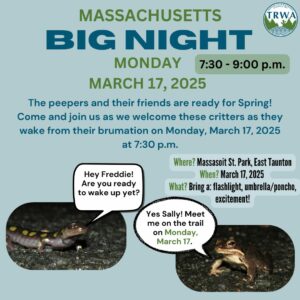
Join us to witness the annual migration of amphibians as they awake from their brumation! We don’t have a way to confirm the date with our amphibian friends, but the weather looks good for March 17th and we don’t want to miss it. This event is being led by Brian Bastarache, TRWA Board Member and Bristol County Agricultural High School Environmental Conservation Department Chair.
Meeting Place- Massasoit State Park (1361 Middleboro Ave., East Taunton). Enter a short distance and park. Brian Bastarche will be waiting to lead the group.
What is the “Big Night”?
Every spring (March or April), on the early rainy nights when the temperature is above 40 degrees, thousands of amphibians like salamanders, wood frogs, and spring peepers leave their underground winter burrows in search of vernal pools.
Vernal pools are temporary shallow wetlands that fill with water during the rainy season and dry up in the spring. The amphibians will spend a few days or weeks at the vernal pool to mate. Frogs will serenade potential mates using their songs, while salamanders use courtship dances. Females will then lay their eggs in the pools before returning to the forest. Before warmer weather dries up the vernal pool, the eggs will hatch, and larvae will grow into fully formed frogs and salamanders, who will then seek out more permanent bodies of water to live out their adult lives.
This phenomenon is referred to as the “Big Night”. People from across the Northeast will watch the weather carefully in hopes of witnessing this extraordinary phenomenon. Many will go as far as stopping traffic in the pouring rain to allow these unique creatures to safely cross the road.
Is “brumation” the same as “hibernation”?
Brumation is to reptiles what hibernation is to mammals. When temperatures begin to drop and the days begin to get shorter, reptiles seek out a warm, safe hiding place where their metabolism slows to the bare minimum and they rest until the climate changes again for spring time. Hibernation typically lasts longer than brumation. A bear’s hibernation period can last for many months, whereas a lizard’s brumation period might only last a month or two. Brumation is essential to the survival of particular reptile species because they are incapable of raising their body temperature when the seasonal weather changes.
For more information, visit sites such as:


